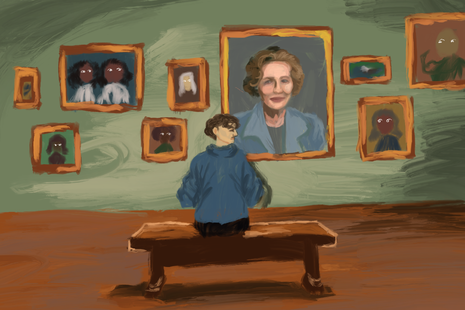

Keir Starmer recently removed a painting of Margaret Thatcher from Downing Street, and who can blame him? Unlike we might hope, he supposedly didn’t remove it because of Maggie herself but because he doesn’t like pictures of people staring down at him. He didn’t like her gaze. He didn’t enjoy being perceived. We look at art all the time, so what’s wrong with those pieces that stare back? Why not give those in the painting, especially historical or fictional women trapped inside them (Thatcher excluded, maybe), a little agency?
La Fiancée Hésitante (‘The Reluctant Bride’) by Auguste Toulmouche has become a meme epitomising feminine rage. Women and girls all over the internet have taken the bride’s defiant stare and reworked it to express their personal, deeply feminine experiences. The reluctant bride gazes angrily at her viewer, asking for an escape from the world that the male artist has made for her. This reappropriation has taken the painting’s power from Toulmouche and placed it into the bride’s hands. The torch has been passed from man to woman.
“Usually, men can gawk at nude women in paintings, and avoid confrontation”
Male control and behaviour enrages us and Toulmouche depicts just that. Manet, however, seems to have a penchant for depicting another common emotion that women experience when encountering very male behaviour: boredom. Mansplaining is real. Arrogance is dull. In Le Déjeuner sur l’herbe (‘Luncheon on the Grass’), Manet paints a woman lazing naked at a picnic with two fully-clothed men who are deep in conversation, seemingly unaware of their nude companion. The woman gazes out of the painting, locking eyes with her viewer. We should be made to feel like voyeurs to her open sexuality, her male artist fetishising her naked body by contrasting it to these clothed men. But her expression is one of boredom. Usually, when women are shown to be naked by their — let’s face it, male — artists, they do not gaze back at us. The viewer can gawk to their heart’s content but avoid confrontation. As the subject expresses her boredom, Manet allows us to interact with this nude woman in a way that transcends the sexual. We are invited into her intellectual world and not her physical one.
It is Goya’s La maja desnuda (‘The Naked Maja’) who invites us into her physical world. Lying nude, pubic hair on show, arms behind her head, the subject gazes knowingly outward. Goya’s painting is confrontational and was therefore controversial. The artist was dragged to trial by an angry mob for his moral depravity. The woman’s bodily autonomy was a shock to eighteenth-century senses and her enticing yet admonishing gaze led a man to inquisition.
“Maybe it is good for us to be stared back at once in a while”
But all these paintings are by men! No matter how much agency we attribute to the women in them, no matter how uncomfortable they might make their audience feel, they were painted to satisfy the male gaze. Do men enjoy women looking back at them? Or does their boldness and sudden agency rouse their discomfort? For Sir Keir, discomfort was the primary emotion.
Paintings by women can be read very differently. Élisabeth Vigée Le Brun’s self-portraits gaze at their viewer, warmly inviting them to admire her work with her soft smile. The portrait of herself and her daughter Julie, again, shows two female subjects staring out of a painting. Unlike in paintings by men, there is no reproach or yearning in their eyes, but genuine happiness. Feminist author Simone de Beauvoir found le Brun’s portraits to be narcissistic, accusing the artist of endlessly portraying her “smiling maternity”. Given the delightful contrast le Brun’s depictions of the female experience offer to depictions by male artists, de Beauvoir’s comment seems harsh at first. Other women artists, however, do not create such glowing accounts of womanhood. Artemisia Gentileschi depicts women in powerful and often violent roles. Her heroines are engaged in action and not distracted by the fourth wall. Does this render le Brun’s smiling women products of the male gaze? Do they gaze at us as though they must always please their male viewers? Or was de Beauvoir too critical of a happy woman who simply enjoyed being a mother?
Art is for our pleasure — or displeasure if you hate galleries — but we never stop to consider how paintings look back at us, unless directly confronted by it. If Keir Starmer found being perceived by someone, a woman no less, unnerving, then think of all the (more favourable) women in art who have found being perceived cruel or voyeuristic. Maybe it is good for us to be stared back at once in a while. It reminds us of the harm of objectification. Art itself may be an object waiting for perception, but the women depicted in it are not.










